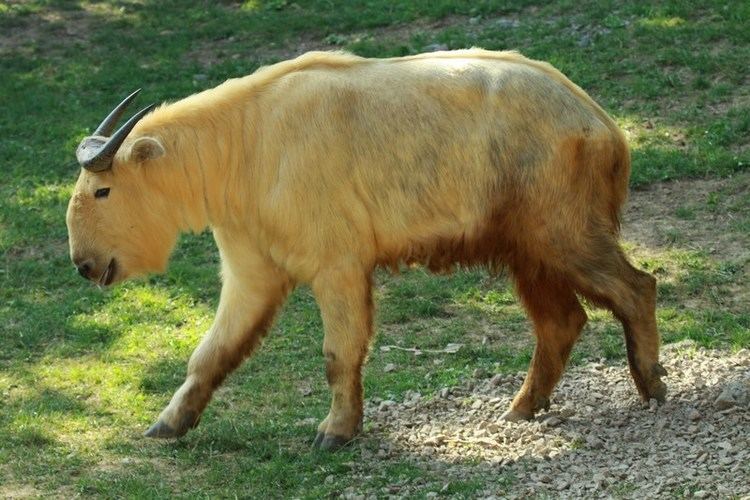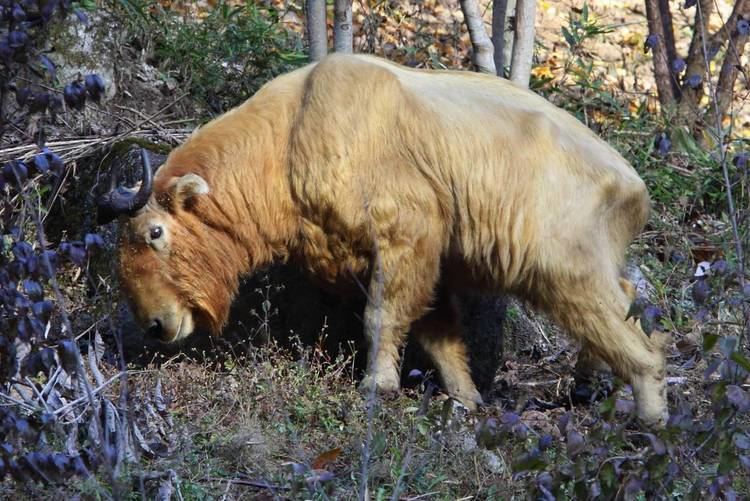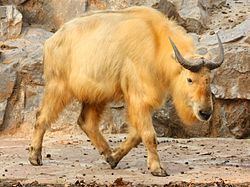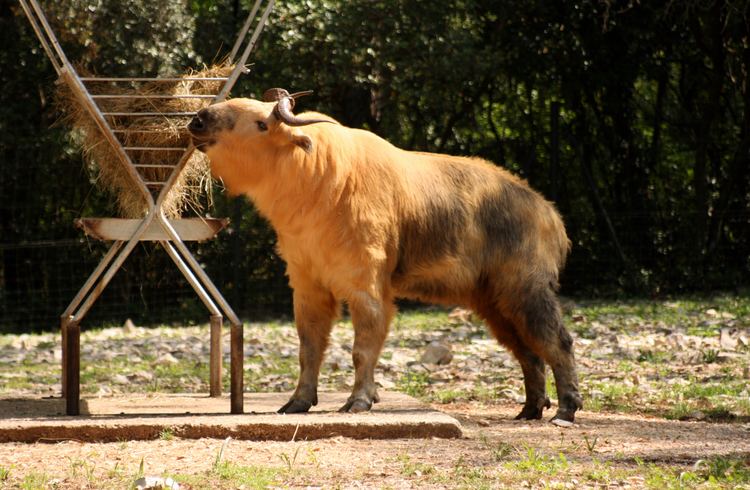Genus Budorcas Rank Subspecies | Phylum Chordata Order Even-toed ungulate | |
 | ||
Scientific name Budorcas taxicolor bedfordi Similar | ||
The Golden Takin (Budorcas taxicolor bedfordi) is an endangered goat-antelope native to the People's Republic of China & Bhutan.

Golden Takins have unique adaptations that help them stay warm and dry during the bitter cold of winter in the rugged Himalayan Mountains. Their large, moose-like snout has large sinus cavities that heats inhaled air, preventing the loss of body heat during respiration. A thick, secondary coat is grown to keep out the cold of the winters and provide protection from the elements. Another protection is their oily skin. Although Golden Takins do not have skin glands, their skin secretes an oily, bitter-tasting substance that acts as a natural raincoat in storms and fog. Its skin is also said to be the source of the legend of the Golden Fleece.

The Golden Takin (pronounced tah-kin) is a large, muscular, hoofed mammal sometimes referred to as a goat-antelope, as it possesses similar traits to goats and antelope, and is most closely related to sheep, aoudad, or Barbary sheep of North Africa. Split hooves help takins move around easily in their rocky habitat. They also have an odor that smells like a strange combination of horse and musk. Both males and females have shiny black, crescent-shaped horns that grow from the center of their massive head and can reach up to 35 inches (90 centimeters) in length.

Each spring, Golden Takins gather in large herds and migrate up the mountains to the tree line, an altitude above 14,000 feet (4,300 meters). As cooler weather approaches and food becomes scarce, they move down to forested valleys. Golden Takins use the same routes during movement throughout the mountains despite where they are going. This creates a series of well-worn paths through the dense growths of bamboo and rhododendrons that lead to their natural salt licks and grazing areas.

Because of their large, powerful bodies and impressive horns, Golden Takins have few natural enemies other than bears, wolves, leopards, and dholes. They are generally slow moving but can react quickly if angered or frightened. When needed, they can leap nimbly from rock to rock. If they sense danger, Golden Takins warn others with a loud "cough" that sends the herd running for cover in the dense underbrush, where they lie down to avoid being seen. Takins can also make an intimidating roar or bellow.

Golden Takins eat many kinds of alpine and deciduous plants and evergreens, and almost any vegetation within reach. This includes the tough leaves of evergreen rhododendrons and oaks, willow and pine bark, bamboo leaves, and a variety of new-growth leaves and herbs. They can easily stand on their hind legs, front legs propped against a tree, to reach for higher vegetation if they need to, and use their powerful bodies to push over small trees to bring leaves closer.
Like cows and sheep, Golden Takins are ruminants and pass food into the first stomach, the rumen, when they first swallow it. Microbes in the rumen help digest very small particles of food. Larger particles pass into a second chamber that regurgitates these particles, called cud, back into the mouth to be chewed into pieces small enough to be digested properly. Golden Takins typically eat in the early morning and again in the late afternoon. They spend the day under the cover of dense vegetation, venturing into the open only on cloudy or foggy days.
Golden Takins communicate using a variety of body postures. For example, a male shows dominance with an erect posture and a raised neck and chin. He might position his body sideways to another Takin to emphasize his size. One signals their aggression with a head-down posture, holding its neck horizontal and rigid, with the head and horns hooked to one side. A lowered head, an arched back, snorting, and head crashing often follow prolonged eye contact between individuals.
The scent of another takin’s skin or urine offers information, too. In particular, pheromones in a takin’s urine may advertise sexual status and identity. To enhance this type of communication, a males spray their own forelegs, chest, and face with urine, and females soak their tail when urinating.
The size of herds changes with the seasons: during spring and early summer, herds can number up to 300 animals; during cooler months, when food is less plentiful, the large herds break up into smaller groups of 10 to 35 Golden Takins as they head up the mountain. Herds are made up of adult females (called cows), kids (young takin), subadults, and young males. Older males, called bulls, are generally solitary except during the rut, or mating season, in late summer. Normally solitary, bull Takins meet up with herds for a short time during the rut. They bellow loudly to attract cows and notify other bulls of their presence. They may find Takin cows by tracking their scent. Once they meet, a bull sniffs and licks the female to determine if she is receptive.
Takin cows seek out areas of dense vegetation to give birth to a single kid in early spring (twins are rare). Within three days of its birth, a takin kid is able to follow its mother through most types of terrain. This is very important if bears or wolves are nearby or if the herd needs to travel a long distance for food. If young Taken are separated from their mother, it lets out a noise to alarm the mother, and the mother answers with a low, guttural call that allows for them to reunite. A takin kid eats solid food and stops nursing at around two months old, although it may continue to stay near Mom until after her next calf is born. Horns begin to grow when the takin kid is about six months old. At birth, takin kids are much darker than adults to give them camouflage from predators; they even have a dark stripe along the back that disappears as the youngsters gets older. Their coat gets lighter in color, longer, and shaggier as they get older.
Life span: 16 to 18 years in the wild, up to 20 years in zoos Gestation: 6 to 7 months Number of young at birth: 1 (twins are uncommon) Age of maturity: 2 years Size: Length - 5 to 7.3 feet (1.5 to 2.2 meters) Size: Shoulder height - 3.3 to 4.5 feet (1 to 1.4 meters) Weight: Females up to 616 pounds (280 kilograms); males up to 770 pounds (350 kilograms) Weight at birth: 11 to 15 pounds (5 to 7 kilograms)
